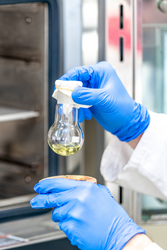The Essential Lab Workhorse: A Look Inside Lab Drying Ovens
17th Jan 2024
Every laboratory, from bustling research facilities to quiet environmental monitoring centers, relies on a diverse array of equipment to perform its vital tasks. Amongst these essential tools lies the lab drying oven, a seemingly simple yet remarkably versatile apparatus that plays a crucial role in numerous scientific endeavors.
Demystifying the Lab Drying Oven: What is it?
At its core, a lab drying oven is a controlled-environment chamber that utilizes heat to remove moisture from various materials. Typically resembling a small oven or microwave in appearance, these instruments are equipped with adjustable temperature settings and heating elements, allowing for precise control over the drying process.
The inner chamber of the oven is usually made from corrosion-resistant materials like stainless steel to withstand the constant exposure to heat and often harsh chemicals. Insulation surrounds the chamber, minimizing heat loss and ensuring efficient use of energy.
Beyond Drying: Unveiling the Diverse Applications of Lab Ovens
While "drying" may be the core function, lab drying ovens find application in a surprisingly wide range of scientific endeavors. Here are some of the most common uses:
- Drying Samples: This is the most fundamental function. Ovens are used to remove moisture from various samples, including:
- Biological samples like tissues, plants, and microorganisms for further analysis.
- Chemical samples to remove solvents or purify substances.
- Food samples to determine moisture content or prepare them for further testing.
- Sterilization: Ovens can be used to sterilize laboratory equipment and glassware by eliminating any bacteria or microorganisms present. This is crucial for maintaining a sterile environment and preventing contamination in experiments.
- Curing: This process involves controlled heating to solidify or harden certain materials, such as resins, paints, or adhesives. Lab ovens provide precise temperature control, ensuring proper curing and avoiding damage to the material.
- Heating and Testing: Ovens can be used for various heating and testing applications. For example, they can be used to:
- Heat treat metals or other materials to change their physical properties.
- Accelerate chemical reactions by providing a controlled warm environment.
- Evaporate solvents or solutions to concentrate them or determine their residue content.
Exploring the Different Types of Lab Drying Ovens:
Not all lab drying ovens are created equal. Different types cater to specific needs and applications. Here are some common variations:
- Gravity Convection Ovens: These ovens rely on natural convection currents for air circulation, heating the chamber slowly and evenly. Ideal for general-purpose drying and heat treatment applications.
- Forced Air Convection Ovens: These ovens utilize fans to circulate warm air within the chamber, resulting in faster and more uniform heating. They are preferred for tasks requiring rapid drying or when even temperature distribution is critical.
- Vacuum Ovens: These ovens operate under reduced pressure, allowing for gentle drying at lower temperatures. This is beneficial for materials sensitive to heat or for removing volatile solvents without compromising the sample.
Choosing the Right Lab Drying Oven:
Selecting the appropriate oven for your specific needs requires careful consideration of several factors:
- Temperature range: Choose an oven with a temperature range exceeding the maximum temperature required for your application.
- Chamber capacity: Select an oven with sufficient size to accommodate the sample volume you intend to dry.
- Features and functionalities: Consider additional features like programmable timers, data logging capabilities, or specialized safety features based on your specific needs and safety protocols.
Beyond Efficiency: Safety Considerations for Lab Drying Ovens
While lab drying ovens are valuable tools, it is crucial to prioritize safety when operating them. Always follow the manufacturer's instructions and adhere to general laboratory safety practices.
Here are some key safety tips:
- Wear appropriate personal protective equipment (PPE) like gloves and safety glasses when handling hot materials or working with potentially hazardous chemicals.
- Ensure proper ventilation, especially when working with volatile solvents or flammable materials.
- Never place flammable materials near the oven or leave it unattended while in operation.
- Regularly maintain and calibrate the oven according to the manufacturer's recommendations.
By understanding the capabilities and limitations of lab drying ovens, coupled with safe operation practices, these versatile tools can be invaluable assets in any laboratory, facilitating precise and efficient sample handling and contributing to the success of various scientific endeavors.
This blog post provides a brief overview of lab drying ovens. With a vast array of applications and various models available, these instruments offer a valuable resource for researchers and scientists across diverse fields.
Contact us today to learn more about how we can help you achieve your healthcare supply chain goals.
(732) 447-1100 // info@cenmed.com

